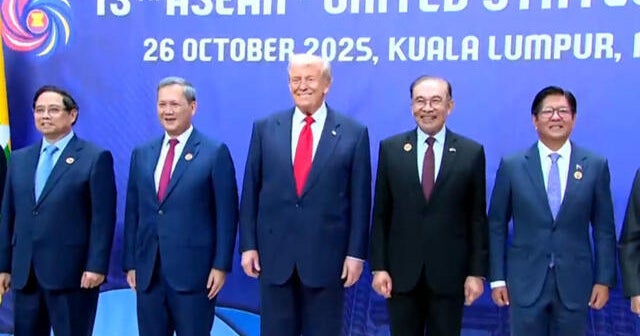‘Ozempic’ economy: global forecaster’s warning for Australia as NSW growth languishes
Higher unemployment, Donald Trump’s tariff war and a slowdown in wages growth will drag on Australia’s economy and reduce shoppers’ appetite for spending, according to bleak predictions from a major global economics forecaster.
Oxford Economics expects the consumer-driven lift in economic growth that began mid-year will soon start to wane, with slow growth in NSW presenting the largest risk to the country’s nascent economic recovery. The completion of major transport projects in Victoria and NSW would also hamper growth, Oxford warned.
The predictions come just days before the release of inflation data that will form a central part of the Reserve Bank’s consideration of a possible rate cut next Tuesday. Financial markets put the chance of a rate cut at 69 per cent.

Shoppers, after filling themselves mid-year, are tipped to go on a diet through the rest of 2025 and into 2026.Credit: Renee Nowytarger
The OECD and International Monetary Fund expect Australia to be among 2025’s fastest-growing developed nations, in part due to consumers getting their spending mojo back thanks to cuts in official interest rates.
Loading
Household spending, as tracked by the Australian Bureau of Statistics, lifted between May and July but effectively stopped in August as consumers started to close their wallets.
Oxford’s head of economic research, Harry Murphy Cruise, said the mid-year increase in spending was apparently due to one-off factors, including back-to-back Easter and Anzac Day holidays that encouraged people to take longer getaways, while retailers had engaged in “unusually generous” discounting to entice shoppers.
Real wages growth, which had improved sharply over the past 18 months, is also slowing.
“That spending momentum will fade with those temporary boosts in the rearview mirror,” he said.
“Meanwhile, households’ appetite to spend will be Ozempic-ed as unemployment edges higher, real wage gains moderate, and global uncertainty clouds the outlook.”
Oxford believes real per-person spending will increase 0.8 per cent. Consumers will be unlikely to regain full confidence to spend until late next year and into 2027.
At the state level, Oxford is forecasting Queensland (gross state product growth of 2.4 per cent in 2025-26) and Western Australia (2.3 per cent) to continue supporting the economy.
Victoria’s economy is expected to be the third-strongest with growth of 1.9 per cent – and NSW the slowest at 1.4 per cent. Both economies are tipped to slow, in part due to the completion of mega-infrastructure projects such as metro rail projects in Sydney and Melbourne.
“With infrastructure pipelines past their peaks, the baton has shifted to households, who are only slowly returning to spending as real incomes improve,” Oxford noted.
Recovery of household spending in Victoria and NSW, which also have the nation’s largest mortgages, will hinge on whether the Reserve Bank continues to ease monetary policy after three rate cuts so far this year.
Expectations of a cut lifted after poorer-than-expected employment figures showed the jobless rate at a four-year high in September. Economists are expecting this week’s inflation report to show price growth lifting in the past three months.
Oxford expects unemployment to keep rising, noting a lift in youth unemployment – which has climbed from 8.9 per cent in March to 10.5 per cent – is a sign of the slowdown in the jobs market.

Donald Trump’s ongoing tariff war flared at the weekend, with the president threatening a 10 per cent tariff on Canadian goods.Credit: AP
Higher than expected inflation does not mean the Reserve will necessarily baulk at a rate cut.
Inflation has climbed to 3 per cent in the United States, where the Federal Reserve’s inflation target is 2 per cent. But financial markets expect the Fed’s monetary policy committee to cut rates by a quarter of a percentage point later this week, taking America’s key lending rate to 3.75-4 per cent.
Loading
AMP deputy chief economist Diana Mousina said if underlying inflation rises by 0.8 per cent in the September quarter, taking the annual result to 2.7 per cent, a cut by the Reserve is likely.
“If numbers come in line with our forecasts we expect a November rate cut, given the downside risks in the labour market. But the breakdown in inflation will also be important, to see if higher inflation is occurring in demand-driven parts of the economy,” she said.
Events in the US continue to cloud the global economic outlook. At the weekend President Trump announced he would impose a 10 per cent tariff on imports from Canada – America’s largest trade partner – over a television advertisement from the Ontario provincial government that used footage of former president Ronald Reagan supporting lower tariffs and free trade.
Treasury secretary and Reserve Bank board member Jenny Wilkinson noted in her department’s annual report the Australian economy had shown “resilience” in the face of global trade tensions and ongoing conflict in areas such as the Middle East and Ukraine.
“The global economy is potentially facing the longest stretch of below-average growth since the early 1990s,” she said.
Start the day with a summary of the day’s most important and interesting stories, analysis and insights. Sign up for our Morning Edition newsletter.
Most Viewed in Politics
Loading


















































